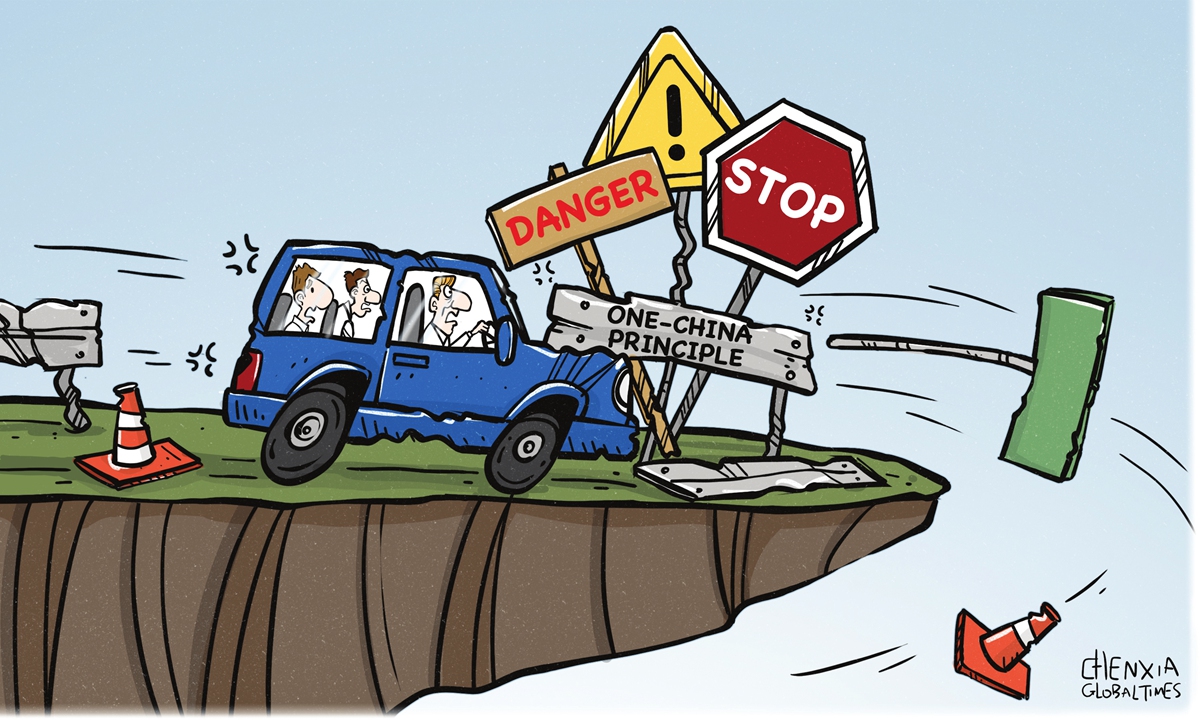
Illustration: Chen Xia/GT
Following US House Speaker Nancy Pelosi's provocative trip to the Taiwan island, another US congressional delegation landed on the island on Sunday on an unannounced two-day visit.
The US and Democratic Progressive Party (DPP) drums pound louder to incite further provocation against One China principle. DPP-allied neoconservatives dominate President Biden's national security state and Congress. Their frenzied, media-amplified calls to fight China conveniently mask US debacles including the Afghanistan withdrawal and the US' role in the Ukraine conflict.
The Doomsday Clock metric shows just over a minute remaining before a nuclear holocaust is triggered in Europe or the Indo-Pacific.
Americans still have time to read China's White Paper titled "The Taiwan Question and China's Reunification in the New Era" to change course.
Readers will come to appreciate the seriousness of China's statement that Taiwan is part of China. They will also comprehend China's iron resolve to reunify one China, a non- negotiable objective that will be achieved, in a process that cannot be halted.
Since its founding, the People's Republic of China has reliably fulfilled its promises on core priorities. This consistency unnerves the US neocon and DPP coconspirators. In denial, they falsify history and give lip service to the international order, its laws and rules, all while violating them.
The historical record that Taiwan is part of China is unarguable. Archeological and historical records show that Taiwan has belonged to China continuously since AD 230 when the earliest references of Taiwan are to be found, among others, in Seaboard Geographic Gazetteer compiled by Shen Ying of the State of Wu during the Three Kingdoms Period.
Europeans attempted to colonize Taiwan but were expelled by the Qing Dynasty in 1662. In 1885 the Qing Dynasty established the Province of Taiwan. In 1894 Japan defeated China and forced it to cede the island to Japanese occupiers. The US fought alongside its ally China in their war against Japan, seeking China's win over Japan and its recovery of Taiwan.
Taiwan's status as a part of China is enshrined in international law. The Cairo Declaration signed by China, the US, and the United Kingdom in 1943 stated that all territories Japan had stolen from China, including Taiwan, should be restored to China. The Potsdam Proclamation signed by the same parties in 1945 stated that the terms of the Cairo Declaration shall be carried out. In 1945, Japan signed the instrument of surrender and in it promised to faithfully fulfill the obligations of the Potsdam Proclamation.
After China resumed sovereignty over Taiwan, a civil war pitted the Republic of China (ROC) Kuomintang (KMT) against the Communist Party of China (CPC). Both contended to rule all China, encompassing the mainland and Taiwan island. After being tactically defeated, the KMT retreated to the island pausing the war pending final reunification.
In 1949, the People's Republic of China (PRC) was founded. US displeasure with the CPC prompted it to militarily shield the exiled KMT in the hope the US-allied ROC would someday reunify China by reconquering the mainland. The legitimacy of US efforts collapsed in 1971 when the United Nations ejected the KMT-ruled ROC and seated the PRC as the sole legal representative of the whole China.
Emboldened by US military assurances, the Taiwan authorities, continued its cross Straits political confrontation, but the territorial definition and integrity of One China was never in doubt.
The UN reinforced PRC legal sovereignty over the island in a later resolution stating that "Taiwan, Province of China" is the island's only internationally recognized status.
PRC-averse US politicians artificially carved out a separate military relationship with China's Taiwan island violating China's sovereignty and skirting international law. The US hoped the KMT would someday defeat the PRC, but it became clear that vision was unrealistic. In the 1980s, US subtle machinations gave rise to the DPP secessionist party with an independence platform the China-averse US politicians embraced.
Since the 1980s, the DPP and US neocons have strived in vain to rewrite history and dismiss international law. They also hang their hats on an invalidated Treaty of San Francisco that asserts Taiwan island's status is not determined.
By disregarding UN resolutions, and the Cairo and Potsdam Proclamations, the US continues to flout codified international law. This irrational attachment to a false history reflects desperate DPP and neocon ambitions that will be crushed when reunification inevitably occurs.
The cross-Straits crisis and Russia-Ukraine dilemma are fundamentally different. But they do have one feature in common, namely US meddling that discourages peaceful negotiations and outcomes only to benefit continued US hegemony and increase arms merchant profits.
With one minute left on the Doomsday Clock, there may be time to caution a few key American decision makers. If they read China's recent White Paper, perhaps they can view DPP and neocon rhetoric with a jaundiced eye, and extinguish the fuse they lit that otherwise will explode in war.
The author is a retired Marine Corps infantry officer and a former Pentagon employee. Opinions are of the author and do not represent the US government. opinion@globaltimes.com.cn




